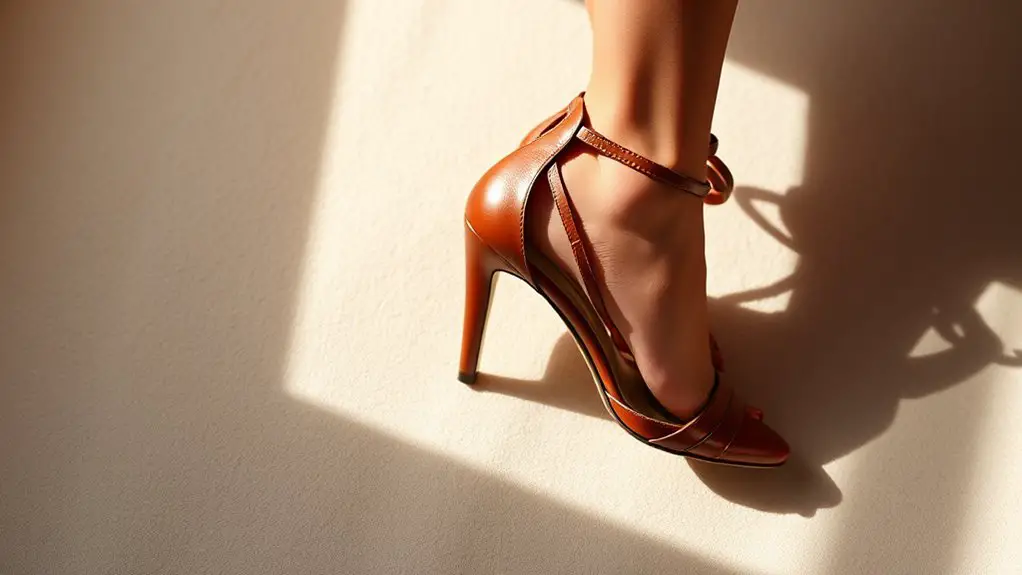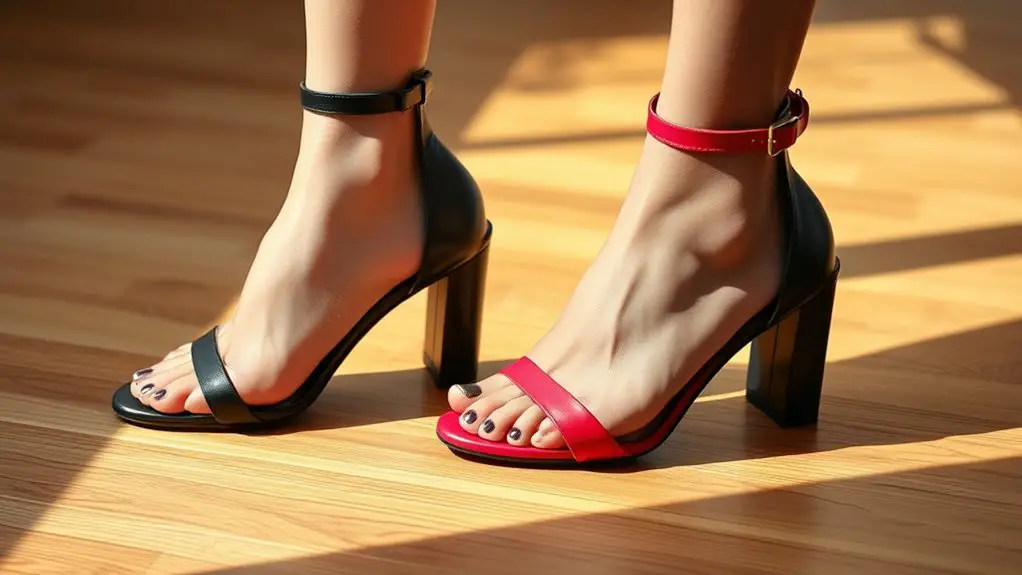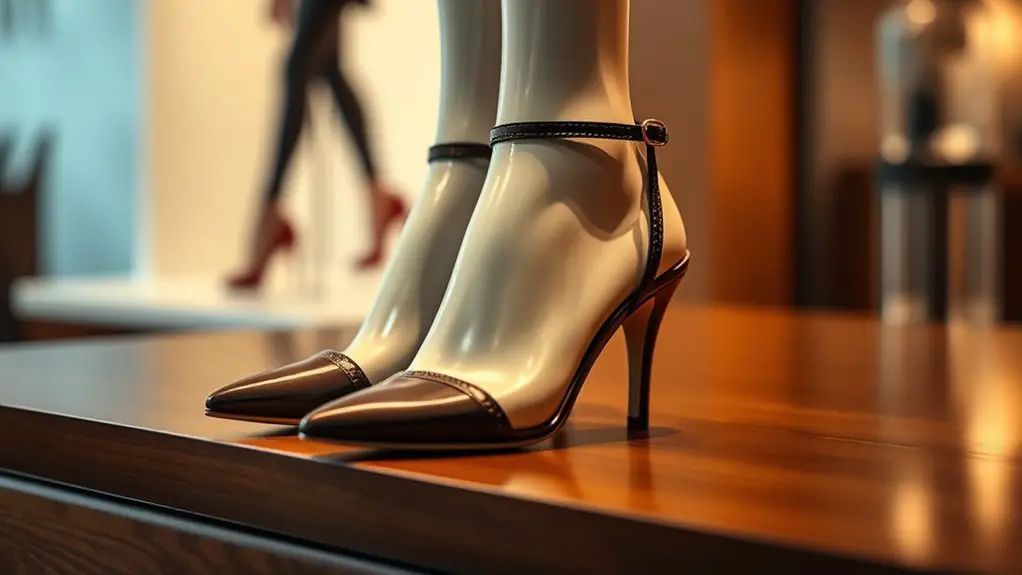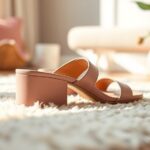Ankle strap heels are indeed better for foot stability. The straps provide essential support, improving foot alignment and reducing the risk of injuries. Compared to traditional high heels, they enhance control and decrease the likelihood of slipping. The secure fit discourages wobbling, while the heel height influences comfort levels. Materials like leather and synthetic options offer different benefits, impacting your experience. To understand how to choose the best pair for your needs, explore further insights.
The Anatomy of Ankle Strap Heels

Ankle strap heels are not just a fashion statement; their design plays an essential role in foot stability. The ankle strap design features a strap that wraps around the ankle, providing additional support to the foot. This configuration can help distribute weight more evenly, reducing the risk of rolling an ankle.
In terms of heel construction, these heels often utilize a solid base to enhance stability. A wider heel can offer better balance, while a narrower one can create a more elegant silhouette but may compromise stability. The combination of the ankle strap and the heel construction creates a synergy that impacts how securely shoes fit on your feet.
When you understand these elements, you can appreciate how ankle strap heels are engineered not just for aesthetics but for functionality, promoting a more secure and stable walking experience. This anatomical knowledge can guide your footwear choices effectively.
How Ankle Straps Enhance Stability
Ankle straps markedly improve foot alignment by securing the heel in place, which promotes a more natural posture while walking. This stability reduces the risk of ankle injuries, as the straps provide enhanced support during movement. Consequently, incorporating ankle strap heels can lead to a more balanced and confident stride.
Improved Foot Alignment
When you slip on a pair of heels with ankle straps, you may not realize how markedly they can improve foot alignment. The strategic design of ankle straps helps maintain ideal foot positioning, promoting a more natural stance. This results in better arch support, which can alleviate some pressure from the balls of your feet.
Here’s a summary of benefits:
| Benefit | Description | Impact on Stability |
|---|---|---|
| Improved Foot Positioning | Keeps feet aligned while walking | Reduces wobbling |
| Enhanced Arch Support | Distributes weight evenly | Increases comfort |
| Secure Fit | Prevents slipping in the shoe | Boosts confidence |
| Better Posture | Encourages upright alignment | Decreases fatigue |
These factors contribute greatly to overall foot stability, enhancing your walking experience.
Enhanced Ankle Support
While wearing heels can sometimes lead to instability, the inclusion of ankle straps greatly mitigates this risk by offering enhanced support. Ankle straps provide a critical function by securing your foot within the shoe, which notably improves ankle stability. This stabilization reduces the likelihood of ankle sprains and other injuries, especially on uneven surfaces. With better foot support, your weight is more evenly distributed, allowing for a more balanced posture. Additionally, the straps help maintain proper alignment of your foot and ankle, minimizing excessive movement. This added security enables you to walk with confidence, reducing fatigue and discomfort over time. Ultimately, ankle straps transform heels from potentially precarious to a more reliable footwear option.
Comparison With Traditional High Heels

Although both ankle strap heels and traditional high heels serve the same purpose of elevating the foot, their structural differences lead to distinct implications for foot stability. Ankle strap heels offer several advantages that can enhance overall foot support compared to traditional styles.
- Increased ankle support: The strap secures your foot, reducing the risk of rolling.
- Better weight distribution: This design helps to distribute your body weight more evenly.
- Enhanced control: You’re less likely to experience unwanted slips, improving your stability.
- High heel alternatives: Ankle strap designs can provide a fashionable yet functional option.
These ankle strap benefits make them a significant choice for those concerned about foot stability. While traditional high heels may be more iconic in fashion, their lack of support can lead to discomfort and instability. When considering your footwear options, it’s essential to weigh these structural differences for better foot health.
The Role of Heel Height in Comfort
When considering comfort in ankle strap heels, heel height plays a vital role in your overall foot stability. Higher heels can disrupt your balance and place additional stress on your feet, while lower heels often provide enhanced support. It’s important to evaluate these factors to guarantee that your footwear choice aligns with both comfort and stability.
Impact of Heel Height
Heel height plays an essential role in the overall comfort and stability of ankle strap heels. Understanding the heel height effects is vital for determining your comfort levels. Higher heels can create additional pressure on the forefoot, while lower heels often provide better weight distribution.
Consider these factors when choosing ankle strap heels:
- Heel Height: Shorter heels generally offer more comfort and stability.
- Foot Shape: Different shapes may respond better to varying heel heights.
- Material: Softer materials can enhance comfort at any heel height.
- Ankle Support: A secure strap can mitigate discomfort, regardless of heel height.
Balancing these aspects will help you select the most comfortable and stable option for your needs.
Balance and Support Factors
Choosing the right heel height is vital, as it directly influences both balance and support while wearing ankle strap heels. A lower heel provides a stable base, enhancing your balance and minimizing the risk of ankle sprains. In contrast, higher heels may compromise stability, requiring advanced balance training to maintain control.
To optimize comfort, you can employ various support techniques, such as selecting heels with padded insoles or wider bases. These features can mitigate discomfort and improve your overall experience. Additionally, understanding your foot’s anatomy and how it interacts with heel height is imperative. Ultimately, balancing aesthetics with practical support will guarantee you enjoy your ankle strap heels without sacrificing foot stability.
Material Matters: Leather vs. Synthetic

While both leather and synthetic materials have their advantages, understanding their distinct characteristics is essential for selecting ankle strap heels that offer both style and foot stability.
Leather provides notable benefits, including:
- Leather Durability: It’s known for its longevity, often molding to the shape of your foot over time.
- Breathability: Natural fibers allow for better air circulation, reducing moisture buildup.
- Support: Leather often offers a firmer structure, enhancing overall foot stability.
On the other hand, synthetic materials present unique features:
- Synthetic Flexibility: They can be more pliable, providing comfort right from the start.
- Lightweight: Typically, synthetic heels weigh less, which can reduce fatigue during wear.
- Variety of Designs: Synthetic options offer a wider range of colors and styles.
Potential Drawbacks of Ankle Strap Heels
Despite their stylish appearance and potential for providing foot stability, ankle strap heels come with several drawbacks that wearers should consider. One primary concern is foot pain, which can arise from prolonged use. The elevation of the heel combined with the strap’s pressure on the foot can lead to discomfort, particularly for those unaccustomed to such footwear.
Additionally, ankle chafing is a common issue. The strap may rub against your skin, causing irritation and potentially leading to abrasions. This is especially true if the strap’s material is stiff or if the fit isn’t adjusted properly.
Moreover, while the straps aim to enhance stability, they can restrict natural foot movement, which might compromise balance over time. As a result, it is crucial to weigh these potential drawbacks against the aesthetic and perceived benefits before committing to wearing ankle strap heels for extended periods.
Styling Tips for Ankle Strap Heels
Ankle strap heels can elevate any outfit, but knowing how to style them effectively is key to maximizing their potential. When it comes to color combinations and outfit pairings, consider the following tips:
- Monochromatic Looks: Pair ankle strap heels with an outfit in a single color for a streamlined appearance.
- Contrasting Colors: Use bold, contrasting hues to make your heels stand out as a statement piece.
- Textures and Patterns: Mix different textures or patterns in your clothing to add depth and interest when wearing ankle straps.
- Dress Lengths: Opt for midi or ankle-length dresses and skirts to showcase the heels while maintaining balance in your silhouette.
Real-Life Experiences: What Wearers Say
Many wearers report that ankle strap heels provide a unique blend of style and comfort, particularly when it comes to foot stability. Personal anecdotes reveal that the added support from the ankle strap can greatly enhance your confidence while walking. Many users have shared testimonials about feeling more secure in their movements, especially on uneven surfaces.
For instance, one wearer noted that the strap helped distribute weight more evenly across the foot, reducing fatigue during long events. Another mentioned that the adjustable straps allowed for a tailored fit, minimizing slippage, which can lead to injuries.
While experiences vary, it’s clear that the stability offered by ankle straps is a common theme in wearer feedback. This support seems to be particularly beneficial for those who prioritize both aesthetics and functionality in their footwear choices. Ultimately, these insights underline the importance of considering personal fit and comfort when selecting ankle strap heels.
Making the Right Choice for Your Feet
When selecting the right ankle strap heels for your feet, it’s essential to take into account factors such as arch support, heel height, and strap width. Understanding your foot shape is key to ensuring comfort and stability.
Consider the following aspects:
- Arch Support: Opt for shoes that provide adequate support for your foot’s natural arch to prevent discomfort.
- Heel Height: A lower heel height often offers better balance, especially if you’re not accustomed to wearing heels.
- Strap Width: Wider straps can distribute pressure more evenly, enhancing stability during wear.
- Material: Choose breathable materials that adapt to your foot shape, providing both comfort and support.
Frequently Asked Questions
Can Ankle Strap Heels Be Worn for Long Hours Comfortably?
When considering comfort features, ankle strap heels can be worn for long hours if they have a moderate heel height and sufficient cushioning. Prioritize styles that offer arch support to enhance overall comfort throughout the day.
How Do I Choose the Right Ankle Strap Heel Size?
Choosing the right ankle strap heel size is essential; it’s like finding the Holy Grail of footwear! Always consult a size guide for accurate heel fitting, ensuring comfort and support while you strut your stuff.
Are Ankle Strap Heels Suitable for Wide Feet?
Ankle strap designs can accommodate wide foot styles if properly sized. Look for adjustable straps and wider silhouettes to guarantee comfort and stability, allowing you to enjoy both style and support without compromising fit.
Do Ankle Straps Limit Circulation in the Feet?
Circulation concerns can arise with snug straps. If they’re too tight, you might experience circulation issues, impacting comfort. Proper ankle support is essential, so make sure your straps fit well to maintain healthy blood flow.
Can Ankle Strap Heels Cause Blisters or Foot Pain?
Yes, ankle strap heels can cause blisters or foot pain. To prevent blisters, try wearing moisture-wicking socks and well-fitted shoes. For foot pain, consider using arch supports or icing your feet after prolonged wear.



